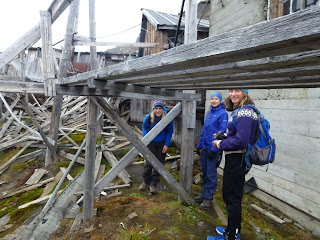So the last time I posted to the blog, I had just gotten home at 4am after the big party. As can be expected, I was really tired for the entirety of Saturday. At around 4, my friends Hannah, Sisi, and Veronika invited me to come with them to the Santa Claus Mine just up on the hill next to our dorms. It looked really close, and the mine was just my kind of creepy, so I agreed to come. It was a lot further and a lot steeper than I thought. It was about a half-hour long nearly-vertical climb. I was very winded by the time I had gotten to the top, and of course I forgot my water bottle.
 |
| Santa Claus Mine |
The mine was abandoned in the early 1900's and the wood was all rotting and crumbly. In retrospect, I finally understand why they'd name a coal mine after Santa Claus - Santa is meant to give coal to naughty children, and this is where he gets it. But has anyone actually ever received coal as a present?
As I said, the wood was very old, but in order to get inside, we needed to climb onto the rickety wooden walkway and into that door pictured above.
Inside it was very dark (We had all forgotten to bring flashlights), but inside we found the little rail-line where the coal trains passed, maybe a kind of scale, and not much else. Where part of the roof was missing, a little snowbank was sitting, having survived the summer.
The last spot we saw was the abandoned mine-shaft. It looked very spooky, and because we had no flashlights, we couldn't venture inside. I want to though. Who knows what Lovecraftian horrors lurks in an abandoned Arctic coal mine?
After a knee-popping descent back down, I returned to Nybyen and made dried-fruit-and-nut energy balls.
The next day was very foggy and rainy, so I lay in bed doing nothing substantial until 2pm, when I decided I needed to get milk and eggs, and also that I wanted to explore more of Longyearbyen. So I wandered around Longyearbyen in the rain, walking the residential streets (there's like 2 or 3), and walked to the coast. Because the rain, the area with birds was flooded, so I just bought my milk and eggs and went home.
 |
| House with reindeer meat outside |
 |
| In front of the flooded coast. The coastal road can be seen rising out from the flooded area in the upper left corner. |
Monday was our first field excursion. We took a 15 minutes bus ride, where we saw the "suburbs" of Longyearbyen composed of lone houses on the hillside, really in the middle of no where already in the middle of no where. We arrived at Bolterdalen, a glacial fjord with a lot of vegetative ground cover. It's strange to be in landscapes that developed in the past millennia or even century rather than back in distant geologic time. Anyway, it was raining, a lot. We spent a good two hours just digging out outcrops in the rain and cold, which was near impossible when we got to a thick, sticky clay layer. But a geologists got to do what they have to, and we persevered and made little holes all along the exposed river bank. I learned how to find strike and dip with a compass and clinometer, a skill I never learned at UChicago, which is embarrassing. I don't understand how UChicago's geology program could have so little focus on field methods. We unfortunately didn't get a chance to do everything at the site, we ran out of time to investigate clast fabrics (the overall directions of rocks embedded in the earth, which give an indication of glacial movement direction. We had a number of students with rifles, but they didn't do a good job of keeping their rifles with them, and we were all yelled at at the end of the day.
At the end of the day I was wet and a little cold, but it honestly wasn't too bad. I had fun, and learned a lot of field techniques. Also shoveling. Which is definitely exercise.
The evening afterwards , I went to have home-made pizza, and on the way back, my walking companion, a German PhD student named Benedict, had us wandering around the hills of Longyearbyen late at night (though it was of course still bright out). It was very strange, and perhaps a waste of time.
The rest of this week has been spent analyzing the samples we collected from the trip and preparing for our upcoming 5 day field work trip to a glacial fjord several valleys over. That's tomorrow, Friday.

















































































